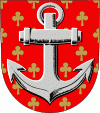Virolahti
 |
The municipality is unilingually Finnish.
The Vaalimaa border crossing, which connects the municipality with Russia, is located in Virolahti.
Virolahti is named after Estonians from Virumaa who traded around the nearby bay, which is also called Virolahti. The first mention of Virolahti dates to 1336. It is mentioned as an independent parish in 1370.
A small part of Virolahti was ceded by Sweden to Russia in the Treaty of Uusikaupunki in 1721. The border was located slightly further west than the modern Finnish-Russian border. In the treaty of Turku of 1743, the rest of Virolahti was ceded to Russia. The northern part of Virolahti became the Miehikkälä parish in 1863.
Before World War I the Russian Emperor Nicholas II used to spend summers with his family in the archipelago of Virolahti with his yacht Standart, Finland being an autonomous province within the Russian Empire between 1809 and 1917.
Virolahti lost some of its area (over 100 km2) to Soviet Union in Paris Peace Treaties, 1947, after World War II.
Map - Virolahti
Map
Country - Finland
 |
 |
| Flag of Finland | |
Finland was first inhabited around 9000 BC after the Last Glacial Period. The Stone Age introduced several different ceramic styles and cultures. The Bronze Age and Iron Age were characterized by contacts with other cultures in Fennoscandia and the Baltic region. From the late 13th century, Finland became a part of Sweden as a consequence of the Northern Crusades. In 1809, as a result of the Finnish War, Finland became part of the Russian Empire as the autonomous Grand Duchy of Finland, during which Finnish art flourished and the idea of independence began to take hold. In 1906, Finland became the first European state to grant universal suffrage, and the first in the world to give all adult citizens the right to run for public office. After the 1917 Russian Revolution, Finland declared independence from Russia. In 1918, the fledgling state was divided by the Finnish Civil War. During World War II, Finland fought the Soviet Union in the Winter War and the Continuation War, and Nazi Germany in the Lapland War. It subsequently lost parts of its territory, but maintained its independence.
Currency / Language
| ISO | Currency | Symbol | Significant figures |
|---|---|---|---|
| EUR | Euro | € | 2 |
| ISO | Language |
|---|---|
| FI | Finnish language |
| SV | Swedish language |















